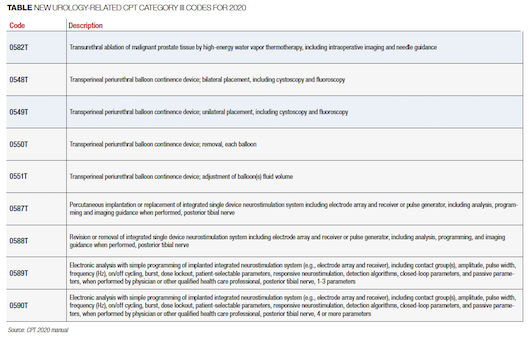Publication
Article
Urology Times Journal
What are Category III codes, and how are they best used for billing?
Author(s):
"Category III codes are designated as temporary codes by the AMA. Even though the codes are considered temporary, they are an integral and important part of the system," write Jonathan Rubenstein, MD, and Mark Painter.


Jonathan Rubenstein, MD

Mark Painter
Current Procedural Terminology codes provide a uniform language for reporting medical services and procedures provided by members of the medical community. The codes are copywritten and managed by the CPT Editorial Panel of the American Medical Association. CPT codes may be designated as Category I codes, which are the typical codes used for reporting services, or Category III codes (also known as “Cat III” or “T codes”), which are created to track the utilization of emerging technologies, services, and procedures. Because Category III codes are a unique subset of the CPT code set, it is important for urologists and practices to understand their use and value, when to use them, and when they can be used for reimbursement.
Also see: When do I need to start consulting a clinical decision support mechanism?
The 2020 CPT code set contains several new Category III codes that may be of interest to urologists (table). In this article, we will provide an overview of this subset of codes and outline the advantages and disadvantages of using them.
Category III codes are temporary, but important
Category III codes are designated as temporary codes by the AMA. Even though the codes are considered temporary, they are an integral and important part of the system. The AMA guidelines for Category III codes include the following: “Category III codes allow data collection for [emerging technologies, services, procedures, and service paradigms]. Use of unlisted codes does not offer the opportunity for the collection of specific data. If a Category III code is available, this code must be reported instead of a Category I unlisted code.”
Unlike Category I CPT codes, Category III codes are not grouped anatomically nor are they grouped by service type (Anesthesia, Surgery, Radiology, Pathology, Medicine, Evaluation and Management). Category III codes instead are assigned a sequential number. To conform to HIPAA format requirements for HCPCS codes, the CPT Category III codes have five characters. The first four characters are numeric (the sequence number assigned by the AMA); the last character is “T.” The descriptions conform to CPT format and terminology.

Category III codes do not need to meet the same standards required by the CPT editorial process for Category I CPT codes. According to the AMA: “For Category I codes, the Panel requires that the service/ procedure be performed by many health care professionals in clinical practice in multiple locations and that FDA approval, as appropriate, has already been received.”
Obtaining a Category III code does not require FDA approval or clearance (of a drug or medical device used in the procedure if required) nor published peer-reviewed evidence for the procedure/service or if required the drug or supply. The CPT editorial panel does require at least one of the following for the procedure/service and the integral drug/supply if required to approve a new Category III code:
• a protocol for a study of procedures being performed
• support from the specialties who would use the procedure
• availability of U.S. peer-reviewed literature
• descriptions of current U.S. trials outlining the efficacy of the procedure.
There are no restrictions on the entity or individual that may submit a request for a CPT code (regardless of category). As part of the process, all submissions for new codes are reviewed by the AMA staff. If the application and applicant meet the requirements set forth by the AMA, the code application is presented to the CPT editorial panel. The editorial panel includes specialty society-appointed members; urologists are appointed by the AUA. Therefore, all codes performed by urologists will likely require the support and recognition by the AUA before they are added to the CPT code set.
Many Category III codes are submitted to the AUA by companies for a technology or procedure for which they would like tracked and monitored for use. When applying for a Category III code, there is an expectation that within 5 years the Category III code will be converted to a Category I code.
Next: Advantages, disadvantages of Category III codesAdvantages, disadvantages of Category III codes
When deciding whether or not to apply for a CPT code, the group or individual considering application must consider the advantages and disadvantages of obtaining a Category III code. Advantages include:
• publication of codes every 6 months, allowing faster adoption of the code (Category I codes are released only once per year)
• as mentioned previously, lower thresholds of supporting data
• early and accurate tracking of the service, which may help with the future application for a Category I CPT code, because the company will be able to provide an accurate count of utilization
• the possibility of payment assignment and specific coverage rules during the investigational/early adoption phase of a procedure.
Disadvantages include:
• system biases that Category III codes are all unproven or lack FDA approval, resulting in blanket non-coverage decisions for services described by Category III codes
• difficulty in locating the codes for new services as they are not located in sections typically searched by payers, physicians, and groups.
Although coverage and payment for the performance of a procedure with a Category III code is not common among the majority of payers when initially released, physicians are required to use the most appropriate code to describe the service provided. Thus, reporting of a Category III code for a service accurately described by the code is appropriate. In the long run, the determination for coverage should be based upon clinical evidence and medical necessity, and not the CPT code category.
Read: Biofeedback training code deleted, replaced with time-based codes
It is imperative to check with your Medicare contractor and insurer guidelines to determine if a procedure, no matter which category, is a covered benefit. In urology, we have seen times when a Category III code is covered where a Category I code is not covered. Since some Category III code procedures are only provided within a clinical trial, it is important to determine whether the Category III code will be submitted for tracking purposes or billing purposes.
When a Category III code is covered, it may be assigned reimbursement on a case-by-case basis or given an Ambulatory Payment Classification level by Medicare, which will pay for the facility/technical component of the procedure but will not pay a surgeon fee. A surgeon may choose to bill their own surgeon fees directly to the patient for a procedure that has no professional component coverage.
Before proceeding with the performance of a procedure with a Category III code, it is important to determine if the reimbursement covers the cost of the device/procedure. We have seen some cases where this is not true and the practice risks losing money for providing the service. Finally, if a provider believes that any of the procedure or technology has been proven both safe and effective as well as reasonable and necessary, some insurers allow coverage on a case-by-case basis or may request coverage through a reconsideration process.
In other words, the same rules that apply to Category I CPT codes apply to Category III codes. Check with the payer prior to providing the service to determine how to proceed.
We want to hear from you! Send coding questions for Jonathan Rubenstein, MD, and Mark Painter to urology_times@mmhgroup.com
The information in this column is designed to be authoritative, and every effort has been made to ensure its accuracy at the time it was written. However, readers are encouraged to check with their individual carrier or private payers for updates and to confirm that this information conforms to their specific rules.

































